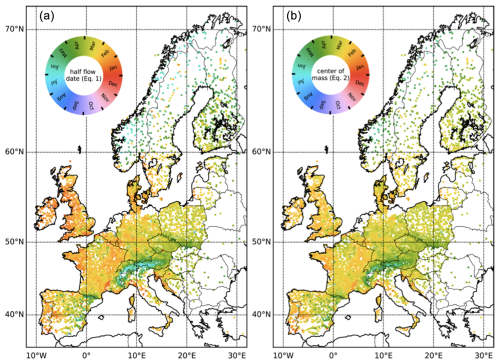the Creative Commons Attribution 4.0 License.
the Creative Commons Attribution 4.0 License.
Technical note: Streamflow seasonality using directional statistics
Kate Hale
Harsh Beria
Hydrological fluxes typically vary across seasons with several existing metrics available to characterize their seasonality. These metrics are beneficial when many catchments across diverse climates and landscapes are studied concurrently. Here, we present directional statistics to characterize streamflow seasonality, capturing the timing of the streamflow (center of mass timing) and the strength of its seasonal cycle (center of mass concentration). We show that directional statistics are mathematically more robust than several widely used metrics to quantify streamflow seasonality. We extend the application of directional statistics to analyze seasonality in other hydrological fluxes, including precipitation, evapotranspiration, and snowmelt, and we introduce a trend analysis framework for both the timing and strength of seasonal cycles. Using an Alpine catchment (Dischma, Switzerland) as a test bed for this methodology, we identify a shift in the streamflow center of mass to earlier in the year and a weakening of the seasonal cycle. Additionally, we apply directional statistics to streamflow data from 11 118 European catchments, highlighting their utility for large-scale hydrological analyses. The introduced metrics, leveraging directional statistics, can improve our understanding of streamflow seasonality and associated changes and can also be used to study the seasonality of other environmental fluxes within and beyond hydrology.
- Article
(5975 KB) - Full-text XML
- BibTeX
- EndNote
Most rivers have distinct seasonal variations in streamflow, which tend to affect floods, droughts, water resources, and ecosystems (Poff et al., 1997; Sivapalan et al., 2005; Berghuijs et al., 2014; Knoben et al., 2018; Blöschl et al., 2017; Patil et al., 2023). Anthropogenic climate change has influenced streamflow seasonality globally with changes that are often especially pronounced in snow-affected regions (Wang et al., 2024). In such regions, climate warming acts to shift the precipitation phase from snowfall towards rainfall, reduces snowpacks, and causes earlier snowmelt, often leading to earlier streamflow (Barnett et al., 2005; Luce and Holden, 2009; Wang et al., 2024; Berghuijs and Hale, 2025). However, shifts in streamflow seasonality can also be substantial in largely snow-free environments (Wasko et al., 2020; Chalise et al., 2021; Wang et al., 2024).
Quantitative summaries of streamflow seasonality across space and/or time typically rely on analyses related to select streamflow characteristics. For example, streamflow records can be described by their multi-year mean monthly flows, which are sometimes normalized by the mean annual flow rate (Pardé, 1933). Such quantitative descriptions can help understand streamflow regime patterns and their changes, but mean monthly flows continue to be time series. Therefore, if one aimed to, for example, create groups of similar flow regimes, further steps are required to characterize streamflow seasonality across many catchments simultaneously (e.g., Haines et al., 1988; Berghuijs et al., 2014; Knoben et al., 2018).
Singular metrics capturing streamflow timing characteristics can be calculated to target when a particular amount of flow has passed since the start of the (water) year, allowing for comparisons of seasonal flow regimes across many catchments and evaluation of flow regime shifts. For example, the half-flow date marks the time elapsed from the beginning of the water year to when half of the annual streamflow is reached (Court, 1962):
where is the half-flow date [T], t is the time (fraction) since the start of the water year [T], and Q(t) is the mean flow rate at time t [L3 T−1 or L T−1] (averaged over the studied period). represents the date corresponding to the median of the cumulative flow distribution. Alternatively, a center of mass represents the point in time when the weighted position vectors of the streamflow relative to this moment (i.e., streamflow multiplied by the time difference to the center of mass), sum to zero:
where is the center of mass [T], t is the time (fraction) since the start of the water year [T], and Q(t) is the flow rate at time t [L3 T−1 or L T−1] (averaged over the studied period). represents the date corresponding to the mean of the cumulative flow distribution. The concepts of half-flow date and center of mass are widely used (e.g., Court, 1962; Stewart et al., 2005; Yang et al., 2007; Regonda et al., 2005; Hodgkins et al., 2003; Luce and Holden, 2009; Clow, 2010; Kormos et al., 2016; Renner and Bernhofer, 2011; Han et al., 2024; Gnann et al., 2021; Chen et al., 2023; Botterill and McMillan, 2023; Almagro et al., 2024). However, it is important to note that while these terms are often used interchangeably, Eqs. (1) and (2) yield different values when the seasonal flow regime is even slightly skewed, which invariably occurs. Additionally, it is important to recognize that seasonal streamflow patterns within water years occur in unbounded time series (i.e., annual cycles), meaning two dates can be considered adjacent even if they fall on opposite ends of the time series. For example, if the water year begins on 1 October, 30 September marks the end of the time series but is also directly adjacent to 1 October.
The strength of streamflow seasonality can also be calculated using a variety of metrics (also commonly applied to precipitation). These metrics quantify the degree of (monthly) variability without considering the sequence of these mean monthly values. For example, a commonly used seasonality index is (Walsh and Lawler, 1981; Eisner et al., 2017)
where Is1 is the seasonality index [–], Qa is the mean annual streamflow sum [L3 T−1 or L T−1], and Qn is the mean monthly streamflow sum [L3 T−1 or L T−1] for month n. Alternatively, the strength of seasonality can be calculated using (Oliver 1980; Han et al., 2024)
or using apportionment entropy (Feng et al., 2013; Wang et al., 2024):
Equations (3)–(5) are straightforward to compute but lose valuable information from the (mean monthly) time series as they ignore the sequence of mean monthly flow rates.
A method that considers both the periodic nature of a mean seasonal streamflow cycle and the sequence of its flow rates is the description of streamflow seasonality using a sine function (e.g., Marvel et al., 2021; Gnann et al., 2020):
Q(t) is the flow rate [L3 T−1 or L T−1] at time t, is the mean streamflow rate [L3 T−1 or L T−1], δQ is a (dimensionless) streamflow seasonality, ϕQ is the phase [T] of seasonal streamflow, and Z is the period of interest [T] set to 1 year. A sine function is most effective for variables with an annual cycle that closely aligns with a sine curve, such as temperature seasonality (e.g., Stine et al., 2009; Berghuijs and Woods, 2016; Marvel et al., 2021). However, in our experience, most streamflow seasonality distributions deviate substantially from a sine curve (e.g., see Fig. 5 of Knoben et al., 2018).
Here, we discuss the use of directional statistics for expressing streamflow seasonality. Directional statistics (Mardia and Jupp, 1972) allow for consideration of the cyclical nature and the sequence of streamflow and can be used for non-sinusoidal time series (e.g., snowmelt). Directional statistics have been widely used to characterize the seasonality of extreme flows and extreme precipitation (e.g., Burn, 1997; Young et al., 2000; Merz and Blöschl, 2003; Laaha and Blöschl, 2006; Dhakal et al., 2015; Villarini, 2016; Blöschl et al., 2017; Berghuijs et al., 2016, 2019; Floriancic et al., 2021; Chagas et al., 2022). Recent developments show these can be adapted to represent the overall intra-annual distribution of streamflow (Jiang et al., 2022; Nan and Tian, 2024; Hanus et al., 2024). Such an approach parallels applications in other scientific fields (e.g., image processing), where centers of mass are calculated for unbounded environments (Bai and Breen, 2008). We show how directional statistics enable simultaneous characterization of both the timing (center of mass timing) and strength (center of mass concentration) of the seasonal streamflow cycle. We compare these directional statistics with widely used metrics (e.g., Eqs. 1–5) and discuss how directional statistics are often (mathematically) more robust. To illustrate potential applications, we use this approach to quantify the seasonality of different hydrological fluxes in an Alpine catchment. Additionally, we apply directional statistics to streamflow time series across 11 117 catchments in Europe and quantify trends in the timing and concentration of the seasonal cycle for these catchments.
The concept of center of mass is not confined to hydrology. It is widely used to determine the average (spatial) position of all mass in a system or object and has many applications in, for example, engineering, astronomy, and biomechanics and can be adapted to a temporal framework. We discuss the seasonal flux equivalent of the center of mass, representing the distribution of a flux in time rather than in space, and account for the cyclical nature of seasonal cycles.
Directional statistics can express the center of mass timing of streamflow, [T]:
and its concentration, R [dimensionless]
where the cosine and sine components of streamflow are
Here, is the center of mass timing expressed as a fraction of a year [T] compared to the start of a (water) year, t is the time (fraction of year) since the start of the (water) year [T], and Q(t) is the flow rate at time t [L3 T−1 or L T−1]. Numerical implementation of the above equations requires considering the time interval at which data are provided (e.g., hourly, daily, or weekly; see Appendix A1 for discrete form). However, unlike the aforementioned methods (Eqs. 1–5), no further time averaging of data is required.
The center of mass timing () represents the unique timing of streamflow concentration within a year, ensuring that the streamflow distribution, weighted by its relative position (streamflow multiplied by the time offset from the center of mass), sums to zero. This is equivalent to the center of mass provided in Eq. (2), except that considers the periodic nature of a seasonal streamflow pattern.
R indicates the strength of mass concentration at that time. An R value close to 1 indicates all streamflow occurs during one isolated moment in the year, whereas R=0 indicates that this mass is symmetrically distributed throughout the year. In the latter case, the center of mass timing would remain undefined (indicating no seasonality), but this would be extremely rare using real-world streamflow data. The (directional) variance of is and the (directional) standard deviation equals . In this technical note, we report the concentration (Eq. 8), not the variance or standard deviation.
To illustrate the use and interpretation of directional statistics, we calculate the center of mass timing and associated concentrations for three example catchments (Fig. 1). The seasonal hydrographs of these catchments show distinct patterns (Fig. 1a–c). The Tiebel River in Himmelberg (Austria) drains a 40 km2 pre-Alpine catchment with most of the flow originating from over 40 springs. These springs are fed by the groundwater flow out of the neighboring Gurktal and remain almost constant throughout the year (largely unaffected by snowmelt and major rainfall). Consequently, its streamflow exhibits minimal seasonality (Fig. 1a). The Alfenz River in Klösterle (Austria) drains a 66 km2 Alpine catchment with a seasonal hydrograph with spring melt (Fig. 1b). The Horndrup River in Sortholmvej (Denmark) drains a 5.5 km2 agricultural and energy-limited catchment with relatively consistent rainfall throughout the year (Bastrup-Birk and Gundersen, 2004) and thereby experiences winter-dominated streamflow (Fig. 1c). The calculated centers of mass timings (here expressed as the fraction of the year since 1 January) and concentration make these intra-annual variations in streamflow quantitative (Fig. 1d–f).
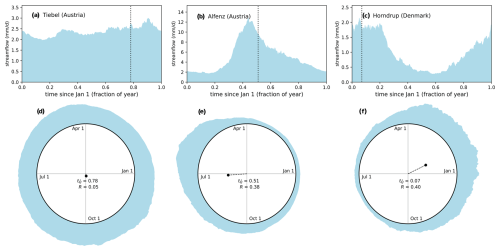
Figure 1Seasonal hydrographs and streamflow seasonality for three example catchments. The top row shows the multi-year mean daily streamflow and center of mass for the Tiebel River at Himmelberg (Austria) (a), Alfenz River at Klösterle (Austria) (b), and Horndrup River at Sortholmvej (Denmark) (c). The bottom row presents the streamflow mass distribution using directional statistics, highlighting the center of mass timing (fraction of a year) and concentration (dimensionless). Streamflow data are obtained from the EStreams database (do Nascimento et al., 2024).
Suggesting directional statistics for analyzing streamflow seasonality may seem redundant considering the many already existing metrics (e.g., Eqs. 1–5). However, directional statistics consider the periodic nature and sequence of mean seasonal flow rates, regardless of the analysis start date, and can be used for non-sinusoidal time series. It thereby can have several advantages over commonly used methods used to summarize seasonality. We illustrate this using simple examples demonstrated below. We acknowledge that no single metric can fully replace all others as the choice of metrics depends on the specific case and questions at hand. In many instances, combining different metrics (including beyond those discussed in this paper) likely yields the most insights.
3.1 Robust timings and shifts
Directional statistics offer an advantage to evaluating streamflow seasonality across space and through time by eliminating the need to specify a start date for the water year, thereby producing stable and more robust timing results. In contrast, alternative metrics for determining streamflow timing, such as the half-flow date (as defined in Eq. 1) and the center of mass (as defined in Eq. 2), are dependent on an arbitrarily established start date for the water year. While some environments have clearly defined water years, establishing a consistent start date across diverse catchments and climates can be challenging whereby suitable starting dates vary regionally (Wasko et al., 2020; Sun and Cheruvelil, 2024). For example, most of Europe uses 1 October as the start of the water year, whereas 1 November is the norm in Germany (e.g., Renner and Bernhofer, 2011). Note that in considering science questions that compare state or flux timing in the context of a water year, it is inherently required to define a start date regardless of methodology. This may be particularly helpful in some instances, but in many other instances, a defined start date is redundant or unnecessary information.
Whitfield (2013) already illustrated that the selection of a start date can problematically influence the inferred half-flow date (as defined in Eq. 1) and the center of mass (as defined in Eq. 2). We further demonstrate this with an example of a (simplified) flow regime before and after a temporal shift in streamflow (Fig. 2a). In this scenario, the original seasonal streamflow regime peaks after one-third of the year, while the shifted streamflow regime mirrors this but with its flows shifted to 1 month earlier. Using directional statistics, the streamflow center of mass timing has a stable date (independent of the water-year start date). In this case, the date is 0.45 years since the start of the water year for the original streamflow regime and 0.37 years for the shifted streamflow regime. Thus, the center of mass date remains stable, and the temporal streamflow shift is fixed at a physically intuitive value of 1 month (Fig. 2c). In contrast, for the half-flow date (Eq. 1) and the center of mass (Eq. 2), the inferred central timing of streamflow shifts at a different rate than changes in the water-year start date do. Consequently, the inferred timings become unstable (Fig. 2b). This instability indicates a high sensitivity of the inferred streamflow shift to the user's choice of start date (Fig. 2c), and the shift does not align with the intuitive 1-month shift. We recognize that these exemplar streamflow regimes are simplified and that it would be illogical to select the beginning of the water year outside the low-flow season; however, we highlight these examples to demonstrate that similar issues can and likely will arise when evaluating more complex streamflow regimes.

Figure 2Effects of starting date of the water year on inferred streamflow timing. Panel (a) shows an example streamflow regime and a shifted regime, which is shifted in streamflow 1 month earlier. Panel (b) highlights instability in inferred central timing (using methodologies other than directional statistics; Eqs. 1 and 2) of the original regime (not shown for the shifted regime) as the start date of the year is shifted forward. The shift in the selected start date (problematically) affects the inferred temporal streamflow shifts using Eqs. (1) and (2) but would remain stable as 1-month change using directional statistics (c).
3.2 Robust seasonality strength
Streamflow seasonality analyses using directional statistics assess the strength of seasonality based on the original temporal resolution of the dataset. For instance, when daily flow rates are provided, the timing and concentration can be derived from this daily data resolution. In contrast, most metrics that quantify the strength of seasonality (Eqs. 3–5) require binning the data into a longer time interval, typically per month (e.g., Feng et al., 2013; Wang et al., 2024; Oliver, 1980; Han et al., 2024). However, these approaches that rely on binning come with several limitations. First, the theoretical range of seasonality values depends on the binning timescale. Second, Eqs. (3)–(5) do not account for the sequential nature of the (binned) time series, which prevents unambiguous differentiation between short-term variability and seasonal variations. Third, selecting a binning interval length is inherently arbitrary, and, as just stated, this decision impacts both the attainable range of seasonality values and the degree to which the method captures short-term versus seasonal variations.
We exemplify such limitations based on a 15 min hydrograph for 1 year. For this hydrograph, we aggregate data to daily, weekly, and monthly resolution and calculate the strength of seasonality using traditional methods (Eqs. 3–5) and using directional statistics (Eq. 8) (Fig. 3). We also highlight the potential range of the seasonality indices based on a constant flow regime and a flow regime where all flow occurs at one single time interval (indicated in parentheses in Fig. 3) and the seasonality compared to its theoretical maximum value (expressed in percentage). Note that for the entropy-based measure, stronger seasonality is associated with lower entropy values. A time series binned into longer intervals loses a part of its temporal variability and shifts its potential seasonality range (Fig. 3). As a result, the absolute and the relative inferred seasonality strengths shift depending on the binning. For some methods, these changes are very large (e.g., Eq. 4), whereas for other methods, changes are smaller (e.g., Eqs. 3 and 5). However, also in these latter cases, inferred seasonality strengths do not unambiguously differentiate between short-term variability and seasonal variations. Directional statistics are insensitive to these problems (and do not require binning) and thereby have relatively constant absolute seasonality and potential seasonality ranges and quantify seasonal variations without the degree of short-term variations substantially affecting the inferred seasonality strength.
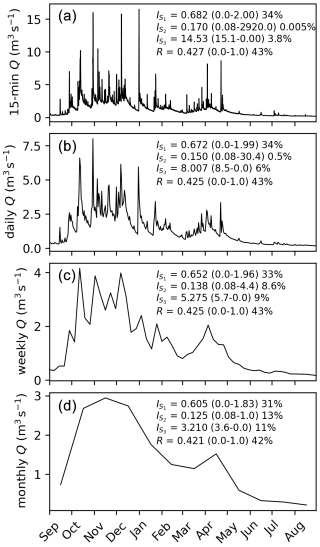
Figure 3Effects of the binning interval on inferred seasonality strength. An example hydrograph given at 15 min (a), daily (b), weekly (c), and monthly (d) resolution and the values of the associated seasonality metrics (Eqs. 3–5 and 8) with their possible range indicated in parentheses (constant regime to most seasonal regime) and the seasonality compared to its theoretical maximum value (expressed as a percentage). This indicates that traditional seasonality metrics tend to be more sensitive to the binning process than directional statistics are. This sensitivity is present in the absolute value of seasonality strength, the values relative to their potential minimum and maximum, and the reference values determining the possible seasonality range. Note that binning is not required for directional statistics.
Most methods used to quantify the strength of streamflow seasonality do not consider the sequential order of streamflow values. However, the sequences can determine the extent of seasonal bias within a flow regime. To illustrate this, we provide a simplified example of two regimes (Fig. 4) that, when analyzed using the seasonality metrics defined in Eqs. (3)–(5) (which do not consider the order of (monthly) flow values), would be assessed as having the same degree of seasonality. In contrast, when applying directional statistics to the concentration (Eq. 3), flow regime 1 is classified as seasonal (R=0.21), whereas flow regime 2 is classified as non-seasonal (R=0.0) due to its identical flow rates across spring, summer, winter, and fall. In theory, strong seasonal variations in flow, with periodicities of 6 months or less, could occur and might be considered indicative of the seasonality of these flow regimes. However, such patterns are typically absent in measured streamflow time series (e.g., see Fig. 5 in Knoben et al., 2018). For other phenomena, such as bimodal precipitation regimes, directional statistics will struggle to characterize the bimodal nature of the annual cycle. It is important to note that the inferred strength of seasonality, as determined by Eqs. (3)–(5), is sensitive to the timing of the seasonal pattern. For example, in Fig. 4 (assuming constant rates within each month), any timing shift in the seasonal cycle would reduce the inferred seasonality by making monthly values more uniform. In contrast, directional statistics are not affected by this issue.
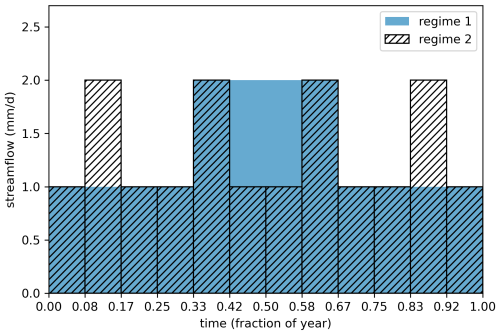
Figure 4Comparison of streamflow regimes illustrating differences in assessing the strength of seasonality. While both regimes appear to have the same degree of seasonality when analyzed using traditional metrics (Eqs. 3–5), directional statistics quantify the fact that flow regime 1 is seasonal (R=0.21), whereas flow regime 2 is non-seasonal (R=0.0) due to identical flow rates throughout the different seasons.
4.1 Water balances
The application of seasonality metrics can extend beyond streamflow. For example, directional statistics can characterize the seasonality of multiple water balance components within a catchment. Here, we illustrate this using the 43 km2 Alpine Dischma catchment in Switzerland (mean elevation 2376 m a.s.l.) (Fig. 5). In this catchment, precipitation is seasonal, with higher rates in summer (, R=0.28) (Fig. 5a). A substantial fraction of annual precipitation falls as snow, as winter temperatures are below zero for part of the year, leading to highly seasonal snowpacks (R=0.75) with a center of mass at the end of winter () (Fig. 5b). Snowmelt from this snowpack is slightly less seasonally concentrated (R=0.72), with a center of mass in spring () (Fig. 5c). While most snow melts in spring, a smaller proportion of snowmelt also occurs during fall and early winter, slightly reducing the seasonal concentration of snowmelt. Energy availability in terms of potential evapotranspiration peaks in summer (, R=0.39) (Fig. 5d), and consequently evapotranspiration rates also have a distinct seasonality (, R=0.36) (Fig. 5e). Streamflow remains low during the winter period (as no snowmelt occurs) and rises following snow melts, and its center of mass occurs in early summer () with substantial seasonality (R=0.46) (Fig. 5f). This approach enables us to track the evolution in the center of mass (and its strength) from snow to streamflow, highlighting seasonal interconnections between different water and energy fluxes.
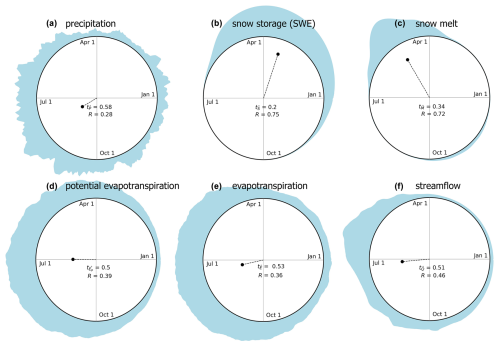
Figure 5Seasonality statistics of several water balance components of the Dischma catchment in Switzerland. Half-hourly precipitation and evapotranspiration are from the Davos flux site (Hörtnagl et al., 2023; data are available at https://www.swissfluxnet.ethz.ch/index.php/sites/site-info-ch-dav/, last access: 14 December 2024). Streamflow data at the Kriegsmatte station are provided by the Federal Office for the Environment (FOEN), and snow data from the Dischma station (MCH.DMA2) are provided by MeteoSwiss. Streamflow and snow depth datasets are available in Magnusson et al. (2025). Snowmelt runoff are modeled at a daily time step using operational snow-hydrological service (OSHD) model from 1998–2022 (Mott, 2023).
4.2 Large-sample studies
A directional statistics approach to seasonality metrics can characterize the spatial gradients and regional differences in the strength and timing of seasonal hydrological fluxes. To illustrate an example, we apply this approach to EStreams, a dataset of 17 130 European catchments (do Nascimento et al., 2024). First, we demonstrate regional seasonality differences by calculating the center of mass timing and concentration for catchments with at least 10 years of continuous streamflow data (11 117 stations).
Streamflow center of mass timing varies notably across Europe, and most variations are spatially highly autocorrelated. Winter-centered flows are widespread in the British Isles, coastal areas of the Baltic states, Denmark, much of western Europe, Portugal, Extremadura and Andalucía (Spain), Italy, and Croatia (Fig. 6a), with varying degrees of seasonality strength (Fig. 6b). These winter-centered flows show the strongest seasonality in Portugal, southwestern Spain, Brittany (France), and a band in northern France stretching towards Luxembourg. Spring-centered flows are prevalent across much of central and eastern Europe, southern Finland, and pre-Alps (Fig. 6a), generally with weaker seasonality, such as in the northern Carpathians. Summer-centered flows are observed in the Alps, Norway, Sweden, and northern Finland (Fig. 6a), with the most pronounced seasonality in the Scandinavian Mountains and the higher regions of the Alps. These maps highlight broad-scale continental streamflow seasonality differences, likely largely driven by climate conditions, while also offering potential insights into the influence of landscape on these patterns. For instance, there is evidence of a geological signature in streamflow seasonality, such as the locally delayed center of mass in the Chalk aquifer in the Thames Basin (England) and northern France (Fig. 6a), or the stronger seasonality observed in Brittany and along a band of Jurassic rock in northern France (Fig. 6b). The center of mass timing (Eq. 7 and Fig. 6a) shows stronger regional timing differences than traditional metrics such as half-flow date (Eq. 1) and center of mass (Eq. 2) (Fig. A1).
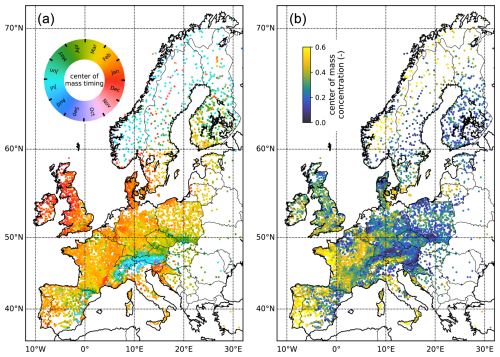
Figure 6Seasonality of flow regimes according to directional statistics. The center of mass timing (a) and its concentration (b) of catchments are shown at the location of the streamflow gauges and vary notably across Europe. Most of these variations are spatially highly autocorrelated. For illustration purposes, we do not show (the small number of) Icelandic catchments and streamflow gauges located east of 32° E.
4.3 Trend analyses
Directional statistics can be applied in trend analyses to evaluate whether the center of mass timing and the strength of the seasonal cycle have trends. The specifics of such trend analyses may vary depending on the exact research questions, the availability of data, and the selected trend estimator. Here, we demonstrate an example using the Theil–Sen estimator. Similar steps could be followed with other methods.
For each catchment, we calculate the center of mass timing values on an annual basis (1 October–30 September) and assess possible trends using the Theil–Sen estimator:
The trend estimator (year per year) is calculated as the median of the differences in dates across all possible year pairs (i and j) based on annual values of (expressed as a fraction of the year). Such a trend analysis must account for the periodic nature of the year. We applied the unwrap function from NumPy (Harris et al., 2020) to to ensure that such discontinuities in are removed, creating a continuous representation of changes over time. Almost identical approaches have been applied to annual flood timings (e.g., Blöschl et al., 2017). These approaches do not require an unwrap function but assume two dates (e.g., cannot be more than 0.5 years apart. However, this assumption can sometimes violate the time's arrow in trend analyses. The Theil–Sen estimator of the concentration βR (one per year) can be calculated as
The trend estimator βR (one per year) is calculated as the median of the differences in dates across all possible year pairs (i and j) based on annual values of R. To conduct these trend analyses, we use the theilslopes function from the scipy.stats module in SciPy (Virtanen et al., 2020).
For instance, trend analysis of the streamflow in the Dischma catchment (same gauge as in Fig. 5) reveals that the center of mass has shifted earlier in the year at a rate of 0.0005 years (or 0.18 d) per year from 1980–2020 (90 % confidence bounds: −0.0010, −0.0001) (Fig. 7a), while the concentration has decreased at a rate of 0.0025 years per year (90 % confidence bounds: −0.0032, −0.0012) (Fig. 7b). This suggests that the streamflow has shifted earlier in the year (7.3 d total) with less seasonality. Note that such an analysis could be applied to a larger dataset or to ask detailed process questions. Such application is not provided as this should be separate studies and not part of this technical note.
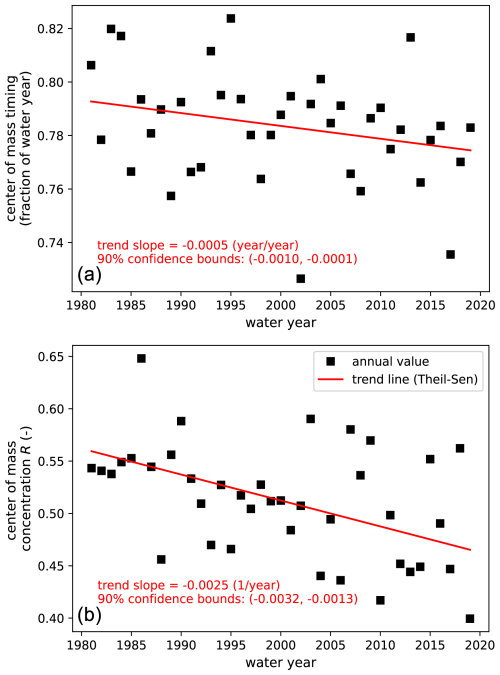
Figure 7Trend analysis of the center of mass timing (a) and its concentration (b) for streamflow in the Dischma catchment. The 90 % confidence interval reflects the uncertainty in the estimated slope. Over the period 1980–2020, center of mass of streamflow has shifted earlier in the year with weaker seasonality.
Streamflow and other hydrological fluxes typically vary across seasons. Existing metrics designed to characterize seasonality often do not account for the periodic nature of seasonal cycles. Here, we use directional statistics to apply the concept of the center of mass for unbounded environments. This approach allows for the simultaneous quantification of seasonal timing (center of mass timing) and strength (center of mass concentration). We demonstrate that using directional statistics provides a more mathematically robust quantification of seasonality compared to several widely used seasonality metrics. To illustrate its application, we analyze data from European catchments, showcasing the method's utility for various water balance components, large-sample hydrological studies, and trend analyses. The introduced metrics, leveraging directional statistics, offer tools for studying the seasonality of environmental fluxes both within and beyond hydrology.
In discrete form, the center of mass timing ( [T]) is calculated as
and its concentration, R [dimensionless], as
where the cosine and sine components of streamflow are
where Qi is the streamflow rate at interval i [L T−1 or L3 T−1], n is the total number of intervals considered, and ti expresses the timing at interval i (years since 1 January).
A Jupyter Notebook to reproduce all figures is available through https://doi.org/10.5281/zenodo.15264750 (Berghuijs, 2025).
European streamflow data are available from the EStreams dataset (do Nascimento et al., 2024). Data from the Dischma catchment are available from Hörtnagl et al. (2023, https://doi.org/10.3929/ETHZ-B-000597213) and Mott (2023, https://doi.org/10.16904/envidat.401).
WRB: methods, analysis, and writing (original draft preparation). KH: methods and writing (reviewing and editing). HB: methods and writing (reviewing and editing).
The contact author has declared that none of the authors has any competing interests.
Publisher's note: Copernicus Publications remains neutral with regard to jurisdictional claims made in the text, published maps, institutional affiliations, or any other geographical representation in this paper. While Copernicus Publications makes every effort to include appropriate place names, the final responsibility lies with the authors.
The authors thank Sebastian Carugati, Anna Luisa Hemshorn de Sánchez, Mira Anand, and reviewers for their valuable suggestions.
This paper was edited by Fuqiang Tian and reviewed by two anonymous referees.
Almagro, A., Meira Neto, A. A., Vergopolan, N., Roy, T., Troch, P. A., and Oliveira, P. T. S.: The drivers of hydrologic behavior in Brazil: Insights from a catchment classification, Water Resour. Res., 60, e2024WR037212, https://doi.org/10.1029/2024WR037212, 2024.
Bai, L. and Breen, D.: Calculating center of mass in an unbounded 2D environment, Journal of Graphics Tools, 13, 53–60, https://doi.org/10.1080/2151237X.2008.10129266, 2008.
Barnett, T. P., Adam, J. C., and Lettenmaier, D. P.: Potential impacts of a warming climate on water availability in snow-dominated regions, Nature, 438, 303–309, https://doi.org/10.1038/nature04141, 2005.
Bastrup-Birk, A. and Gundersen, P.: Water quality improvements from afforestation in an agricultural catchment in Denmark illustrated with the INCA model, Hydrol. Earth Syst. Sci., 8, 764–777, https://doi.org/10.5194/hess-8-764-2004, 2004.
Berghuijs, W.: Streamflow seasonality using directional statistics workflow figures, Zenodo [code], https://doi.org/10.5281/zenodo.15264750, 2025.
Berghuijs, W. R., Sivapalan, M., Woods, R. A., and Savenije, H. H. G.: Patterns of similarity of seasonal water balances: A window into streamflow variability over a range of time scales, Water Resour. Res., 50, 5638–5661, https://doi.org/10.1002/2014WR015692, 2014.
Berghuijs, W. R. and Woods, R.: A simple framework to quantitatively describe monthly precipitation and temperature climatology, Int. J. Climatol., 36, 3161–3174, https://doi.org/10.1002/joc.4544, 2016.
Berghuijs, W. R., Woods, R. A., Hutton, C. J., and Sivapalan, M.: Dominant flood generating mechanisms across the United States, Geophys. Res. Lett., 43, 4382–4390, https://doi.org/10.1002/2016GL068070, 2016.
Berghuijs, W. R., Harrigan, S., Molnar, P., Slater, L. J., and Kirchner, J. W.: The relative importance of different flood-generating mechanisms across Europe, Water Resour. Res., 55, 4582–4593, https://doi.org/10.1029/2019WR024841, 2019.
Berghuijs, W. R. and Hale, K.: Streamflow shifts with declining snowfall, Nature, 638, E35–E37, https://doi.org/10.1038/s41586-024-08523-5, 2025.
Botterill, T. E. and McMillan, H. K.: Using machine learning to identify hydrologic signatures with an encoder–decoder framework, Water Resour. Res., 59, e2022WR033091, https://doi.org/10.1029/2022WR033091, 2023.
Blöschl, G., Hall, J., Parajka, J., Perdigão, R. A. P., Merz, B., Arheimer, B., Aronica, G. T., Bilibashi, A., Bonacci, O., Borga, M., Čanjevac, I., Castellarin, A., Chirico, G. B., Claps, P., Fiala, K., Frolova, N., Gorbachova, L., Gül, A., Hannaford, J., Harrigan, S., Kireeva, M., Kiss, A., Kjeldsen, T. R., Kohnová, S., Koskela, J. J., Ledvinka, O., Macdonald, N., Mavrova-Guirguinova, M., Mediero, L., Merz, R., Molnar, P., Montanari, A., Murphy, C., Osuch, M., Ovcharuk, V., Radevski, I., Rogger, M., Salinas, J. L., Sauquet, E., Šraj, M., Szolgay, J., Viglione, A., Volpi, E., Wilson, D., Zaimi, K., and Živković, N.: Changing climate shifts timing of European floods, Science, 357, 588–590, https://doi.org/10.1126/science.aan2506, 2017.
Burn, D. H.: Catchment similarity for regional flood frequency analysis using seasonality measures, J. Hydrol., 202, 212–230, https://doi.org/10.1016/S0022-1694(97)00068-1, 1997.
Chagas, V. B., Chaffe, P. L., and Blöschl, G.: Process controls on flood seasonality in Brazil, Geophys. Res. Lett., 49, e2021GL096754, https://doi.org/10.1029/2021GL096754, 2022.
Chalise, D. R., Sankarasubramanian, A., and Ruhi, A.: Dams and climate interact to alter river flow regimes across the United States, Earths Future, 9, e2020EF001816, https://doi.org/10.1029/2020EF001816, 2021.
Chen, X., Jiang, L., Luo, Y., and Liu, J.: A global streamflow indices time series dataset for large-sample hydrological analyses on streamflow regime (until 2022), Earth Syst. Sci. Data, 15, 4463–4479, https://doi.org/10.5194/essd-15-4463-2023, 2023.
Clow, D. W.: Changes in the timing of snowmelt and streamflow in Colorado: A response to recent warming, J. Climate, 23, 2293–2306, https://doi.org/10.1175/2009JCLI2951.1, 2010.
Court, A.: Measures of streamflow timing, J. Geophys. Res., 67, 4335–4339, https://doi.org/10.1029/JZ067i011p04335, 1962.
Dhakal, N., Jain, S., Gray, A., Dandy, M., and Stancioff, E.: Nonstationarity in seasonality of extreme precipitation: A nonparametric circular statistical approach and its application, Water Resour. Res., 51, 4499–4515, https://doi.org/10.1002/2014WR016399, 2015.
do Nascimento, T. V. M., Rudlang, J., Höge, M., van der Ent, R., Chappon, M., Seibert, J., Hrachowitz, M., and Fenicia, F.: EStreams: An integrated dataset and catalogue of stream- flow, hydro-climatic and landscape variables for Europe, Scientific Data, 11, 879, https://doi.org/10.1038/s41597-024-03706-1, 2024.
Eisner, S., Flörke, M., Chamorro, A., Daggupati, P., Donnelly, C., Huang, J., Hundecha, Y., Koch, H., Kalugin, A., Krylenko, I., Mishra, V., Piniewski, M., Samaniego, L., Seidou, O., Wallner, M., and Krysanova, V.: An ensemble analysis of climate change impacts on streamflow seasonality across 11 large river basins, Climatic Change, 141, 401–417, https://doi.org/10.1007/s10584-016-1844-5, 2017.
Feng, X., Porporato, A., and Rodriguez-Iturbe, I.: Changes in rainfall seasonality in the tropics, Nat. Clim. Change, 3, 811–815, https://doi.org/10.1038/nclimate1907, 2013.
Floriancic, M. G., Berghuijs, W. R., Molnar, P., and Kirchner, J. W.: Seasonality and drivers of low flows across Europe and the United States, Water Resour. Res., 57, e2019WR026928, https://doi.org/10.1029/2019WR026928, 2021.
Gnann, S. J., Howden, N. J. K., and Woods, R. A.: Hydrological signatures describing the translation of climate seasonality into streamflow seasonality, Hydrol. Earth Syst. Sci., 24, 561–580, https://doi.org/10.5194/hess-24-561-2020, 2020.
Gnann, S. J., Coxon, G., Woods, R. A., Howden, N. J., and McMillan, H. K.: TOSSH: A toolbox for streamflow signatures in hydrology, Environ. Modell. Softw., 138, 104983, https://doi.org/10.1016/j.envsoft.2021.104983, 2021.
Haines, A. T., Finlayson, B. L., and McMahon, T. A.: A global classification of river regimes, Appl. Geogr., 8, 255–272, https://doi.org/10.1016/0143-6228(88)90035-5, 1988.
Han, J., Liu, Z., Woods, R., McVicar, T. R., Yang, D., Wang, T., Hou, Y., Guo, Y., Li, C., and Yang, Y.: Streamflow seasonality in a snow-dwindling world, Nature, 629, 1075–1081, https://doi.org/10.1038/s41586-024-07299-y, 2024.
Hanus, S., Burek, P., Smilovic, M., Seibert, J., and Viviroli, D.: Seasonal variability in the global relevance of mountains to satisfy lowland water demand, Environ. Res. Lett., 19, 114078, https://doi.org/10.1088/1748-9326/ad8507, 2024.
Harris, C. R., Millman, K. J., van der Walt, S. J., Gommers, R., Virtanen, P., Cournapeau, D., Wieser, E., Taylor, J., Berg, S., Smith, N. J., Kern, R., Picus, M., Hoyer, S., van Kerkwijk, M. H., Brett, M., Haldane, A., Fernández del Río, J., Wiebe, M., Peterson, P., Gérard-Marchant, P., Sheppard, K., Reddy, T., Weckesser, W., Abbasi, H., Gohlke, C., and Oliphant, T. E.: Array programming with NumPy, Nature, 585, 357–362, https://doi.org/10.1038/s41586-020-2649-2, 2020.
Hodgkins, G., Dudley, R., and Huntington, T.: Changes in the timing of high river flows in New England over the 20th century, J. Hydrol., 278, 244–252, https://doi.org/10.1016/S0022-1694(03)00155-0, 2003.
Hörtnagl, L., Buchmann, N., Meier, P., Gharun, M., Baur, T., Eugster, W., and Feigenwinter, I.: CH-DAV FP2022.5 (1997–2022), ETH Zurich [data set], https://doi.org/10.3929/ETHZ-B-000597213, 2023.
Jiang, Y., Xu, Z., and Xiong, L.: Runoff variation and response to precipitation on multi-spatial and temporal scales in the southern Tibetan Plateau, J. Hydrol., 42, 101157, https://doi.org/10.1016/j.ejrh.2022.101157, 2022.
Knoben, W. J., Woods, R. A., and Freer, J. E.: A quantitative hydrological climate classification evaluated with independent streamflow data, Water Resour. Res., 54, 5088–5109, https://doi.org/10.1029/2018WR022913, 2018.
Kormos, P. R., Luce, C. H., Wenger, S. J., and Berghuijs, W. R.: Trends and sensitivities of low streamflow extremes to discharge timing and magnitude in Pacific Northwest mountain streams, Water Resour. Res., 52, 4990–5007, https://doi.org/10.1002/2015WR018125, 2016.
Laaha, G. and Blöschl, G.: Seasonality indices for regionalizing low flows, Hydrol. Process., 20, 3851–3878, https://doi.org/10.1002/hyp.6161, 2006.
Luce, C. H. and Holden, Z. A.: Declining annual streamflow distributions in the Pacific Northwest United States, 1948–2006, Geophys. Res. Lett., 36, L16401, https://doi.org/10.1029/2009GL039407, 2009.
Magnusson, J., Bühler, Y., Quéno, L., Cluzet, B., Mazzotti, G., Webster, C., Mott, R., and Jonas, T.: High-resolution hydrometeorological and snow data for the Dischma catchment in Switzerland, Earth Syst. Sci. Data, 17, 703–717, https://doi.org/10.5194/essd-17-703-2025, 2025.
Mardia, K. V. and Jupp, P. E.: Directional Statistics, Academic Press Inc., London, England, ISBN 9780470316979, 1972.
Marvel, K., Cook, B. I., Bonfils, C., Smerdon, J. E., Williams, A. P., and Liu, H.: Projected changes to hydroclimate seasonality in the continental United States, Earths Future, 9, e2021EF002019, https://doi.org/10.1029/2021EF002019, 2021.
Merz, R. and Blöschl, G.: A process typology of regional floods, Water Resour. Res., 39, 1340–1359, https://doi.org/10.1029/2002WR001952, 2003.
Mott, R.: Climatological snow data since 1998, OSHD, EnviDat [data set], https://doi.org/10.16904/envidat.401, 2023.
Nan, Y. and Tian, F.: Glaciers determine the sensitivity of hydrological processes to perturbed climate in a large mountainous basin on the Tibetan Plateau, Hydrol. Earth Syst. Sci., 28, 669–689, https://doi.org/10.5194/hess-28-669-2024, 2024.
Oliver, J. E.: Monthly precipitation distribution: a comparative index, Prof. Geogr., 32, 300–309, https://doi.org/10.1111/j.0033-0124.1980.00300.x, 1980.
Pardé, M.: Fleuves et Rivières, Armand Colin, Paris, France, p. 224, 1933.
Patil, R., Wei, Y., and Shulmeister, J.: Change in center of timing of streamflow and its implications for environmental water allocation and river ecosystem management, Ecol. Indic., 153, 110444, https://doi.org/10.1016/j.ecolind.2023.110444, 2023.
Poff, N. L., Allan, J. D., Bain, M. B., Karr, J. R., Prestegaard, K. L., Richter, B. D., Sparks, R. E., and Stromberg, J. C.: The natural flow regime, BioScience, 47, 769–784, https://doi.org/10.2307/1313099, 1997.
Regonda, S., Rajagopalan, B., Clark, M., and Pitlick, J.: Seasonal cycle shifts in hydroclimatology over the western United States, J. Climate, 18, 372–384, https://doi.org/10.1175/JCLI-3272.1, 2005.
Renner, M. and Bernhofer, C.: Long term variability of the annual hydrological regime and sensitivity to temperature phase shifts in Saxony/Germany, Hydrol. Earth Syst. Sci., 15, 1819–1833, https://doi.org/10.5194/hess-15-1819-2011, 2011.
Sivapalan, M., Blöschl, G., Merz, R., and Gutknecht, D.: Linking flood frequency to long-term water balance: Incorporating effects of seasonality, Water Resour. Res., 41, W06012, https://doi.org/10.1029/2004WR003439, 2005.
Stewart, I. T., Cayan, D. R., and Dettinger, M. D.: Changes toward earlier streamflow timing across western North America, J. Climate, 18, 1136–1155, https://doi.org/10.1175/JCLI3321.1, 2005.
Stine, A. R., Huybers, P., and Fung, I. Y.: Changes in the phase of the annual cycle of surface temperature, Nature, 457, 435–440, https://doi.org/10.1038/nature07675, 2009.
Sun, X. and Cheruvelil, K. S.: Local water year values for the conterminous United States, EarthArxiv [preprint], https://doi.org/10.31223/X5Q121, 2024.
Villarini, G.: On the seasonality of flooding across the continental United States, Adv. Water Resour., 87, 80–91, 2016.
Virtanen, P., Gommers, R., Oliphant, T. E., Haberland, M., Reddy, T., Cournapeau, D., Burovski, E., Peterson, P., Weckesser, W., Bright, J., van der Walt, S. J., Brett, M., Wilson, J., Millman, K. J., Mayorov, N., Nelson, A. R. J., Jones, E., Kern, R., Larson, E., Carey, C. J., Polat, İ., Feng, Y., Moore, E. W., VanderPlas, J., Laxalde, D., Perktold, J., Cimrman, R., Henriksen, I., Quintero, E. A., Harris, C. R., Archibald, A. M., Ribeiro, A. H., Pedregosa, F., van Mulbregt, P., and SciPy 1.0 Contributors: SciPy 1.0: fundamental algorithms for scientific computing in Python, Nat. Methods, 17, 261–272, https://doi.org/10.1038/s41592-019-0686-2, 2020.
Wang, H., Liu, J., Klaar, M., Chen, A., Gudmundsson, L., and Holden, J.: Anthropogenic climate change has influenced global river flow seasonality, Science, 383, 1009–1014, https://doi.org/10.1126/science.adi9501, 2024.
Whitfield, P. H.: Is “Centre of Volume” a robust indicator of changes in snowmelt timing?, Hydrol. Process., 27, 2691–2698, https://doi.org/10.1002/hyp.9817, 2013.
Walsh, R. P. D. and Lawler, D. M.: Rainfall seasonality: description, spatial patterns and change through time, Weather, 36, 201–208, https://doi.org/10.1002/j.1477-8696.1981.tb05400.x, 1981.
Wasko, C., Nathan, R., and Peel, M. C.: Trends in global flood and streamflow timing based on local water year, Water Resour. Res., 56, e2020WR027233, https://doi.org/10.1029/2020WR027233, 2020.
Yang, D., Zhao, Y., Armstrong, R., Robinson, D. and Brodzik, M. J.: Streamflow response to seasonal snow cover mass changes over large Siberian watersheds, J. Geophys. Res.-Earth., 112, F02s22, https://doi.org/10.1029/2006jf000518, 2007.
Young, A. R., Round, C. E., and Gustard, A.: Spatial and temporal variations in the occurrence of low flow events in the UK, Hydrol. Earth Syst. Sci., 4, 35–45, https://doi.org/10.5194/hess-4-35-2000, 2000.
- Abstract
- Introduction
- Seasonality using directional statistics definitions
- Robustness of directional statistics
- Example applications
- Summary
- Appendix A: Methodological equations, discrete form
- Appendix B: Traditional seasonality metrics
- Code availability
- Data availability
- Author contributions
- Competing interests
- Disclaimer
- Acknowledgements
- Review statement
- References
- Abstract
- Introduction
- Seasonality using directional statistics definitions
- Robustness of directional statistics
- Example applications
- Summary
- Appendix A: Methodological equations, discrete form
- Appendix B: Traditional seasonality metrics
- Code availability
- Data availability
- Author contributions
- Competing interests
- Disclaimer
- Acknowledgements
- Review statement
- References





